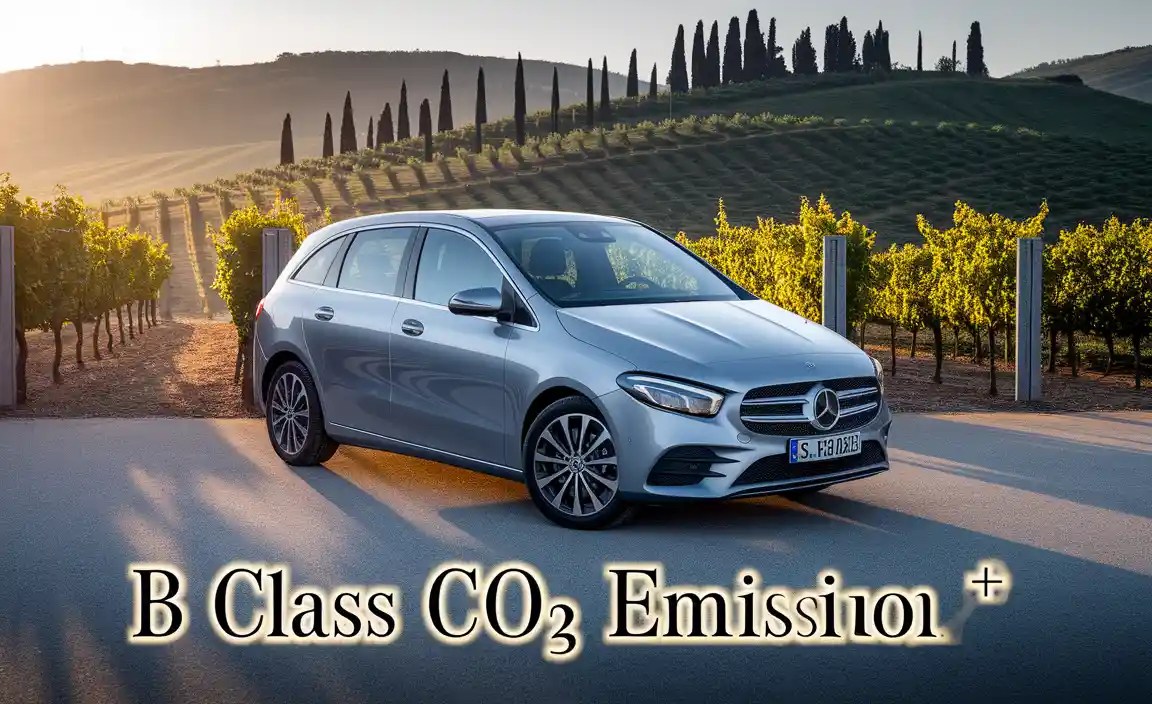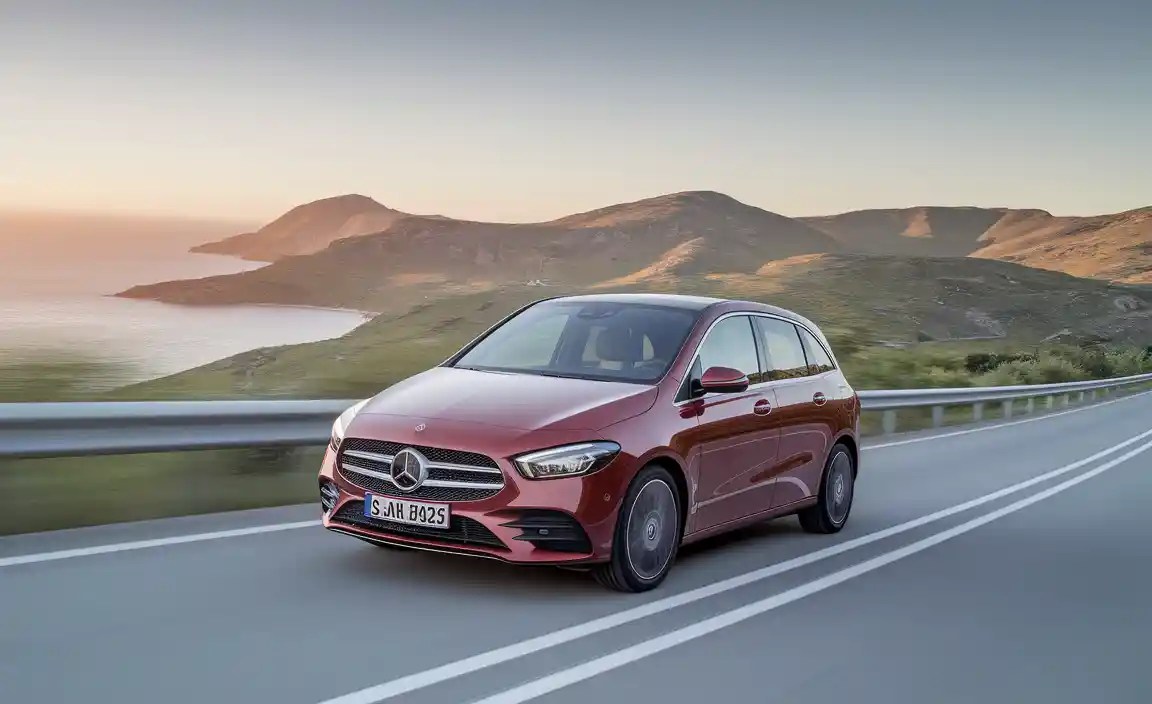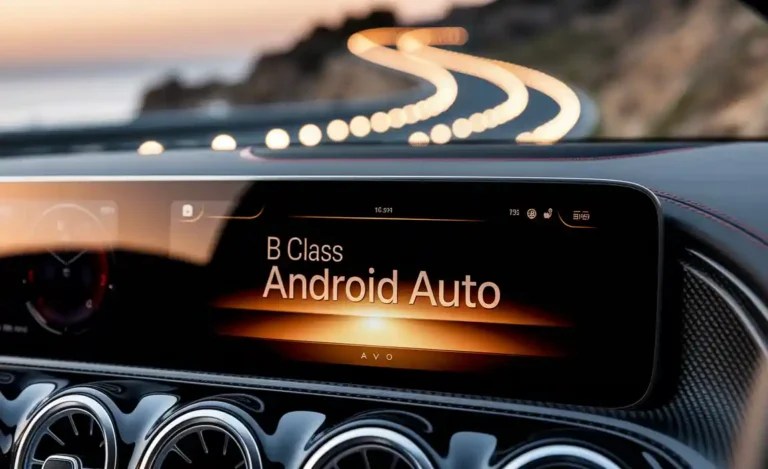B Class CO2 Emissions: Effortless Luxury
Driving a Mercedes-Benz is often about experiencing a unique blend of luxury, comfort, and performance. If you own or are considering a B-Class, you might be curious about its environmental footprint, specifically its CO2 emissions. It’s completely understandable to want your sophisticated driving experience to align with responsible environmental practices.
This guide is designed to demystify B-Class CO2 emissions, making it easy for you to grasp how these figures are determined and what you can do to contribute to a cleaner drive. We’ll break down the complexities into simple terms, ensuring you feel knowledgeable and empowered. Get ready to explore how effortless luxury and lower emissions can go hand in hand.
Understanding CO2 Emissions in the Mercedes-Benz B-Class

When we talk about “CO2 emissions” in the context of cars like the Mercedes-Benz B-Class, we’re essentially referring to the amount of carbon dioxide released into the atmosphere as a byproduct of burning fuel. Why is this important? CO2 is a greenhouse gas, and its accumulation in the atmosphere contributes to climate change. Modern vehicles, including luxury models, are increasingly designed with fuel efficiency and reduced emissions in mind, and the B-Class is no exception. Mercedes-Benz is committed to sustainability, and understanding the CO2 output of your B-Class is a key part of enjoying its luxury features responsibly.
Several factors influence the CO2 emissions of a B-Class vehicle. These include the engine type and size, transmission, the vehicle’s weight, aerodynamic design, driving style, and even tire pressure. For instance, a more powerful engine generally burns more fuel and thus produces more CO2 than a smaller, more efficient one. Similarly, aggressive driving, like rapid acceleration and hard braking, consumes more fuel than smooth, steady driving.
Mercedes-Benz aims to balance the premium experience expected from its brand with environmental considerations. This means continuous innovation in engine technology, powertrain efficiency, and vehicle design to lower CO2 figures without compromising the driving pleasure or luxury features that define the B-Class.
B Class CO2 Emissions: What the Numbers Mean

The CO2 emissions of a car are typically measured in grams per kilometer (g/km). This figure represents the average amount of CO2 expelled by the vehicle for every kilometer it travels. Official figures are usually determined through standardized testing procedures, such as the Worldwide Harmonised Light Vehicles Test Procedure (WLTP). This standardized testing helps ensure that comparisons between different vehicle models are fair and accurate, regardless of where they are sold.
Mercedes-Benz, like all manufacturers, provides these official CO2 emission figures for its B-Class models. These numbers are crucial for several reasons, including:
- Environmental Awareness: They give you a concrete measure of the car’s impact on the environment.
- Taxation and Regulations: In many countries, vehicle taxes and other regulations are based on CO2 emissions. Lower emissions can mean lower taxes and fewer restrictions.
- Fuel Efficiency: Higher CO2 emissions generally correlate with lower fuel efficiency, meaning you’ll be spending more on fuel.
It’s important to note that the official WLTP figures are achieved under specific laboratory conditions. Real-world driving conditions can vary significantly, and your actual CO2 emissions may be higher or lower depending on your driving habits, road conditions, and vehicle maintenance.
Factors Affecting B Class CO2 Emissions
As mentioned, your B-Class’s CO2 output is not static. It’s a dynamic figure influenced by a multitude of factors, both inherent to the vehicle and related to your usage. Understanding these can empower you to make choices that lower your emissions.
Engine and Powertrain
The heart of your B-Class’s emissions lies within its engine and the associated powertrain. Mercedes-Benz offers various engine options for the B-Class, and these are the primary determinants of CO2 output.
- Engine Size and Type: Larger engines, or those more focused on high performance, typically consume more fuel and emit more CO2. For instance, a petrol engine generally emits more CO2 than a comparable diesel engine of the same era, though modern diesel engines have sophisticated emissions control systems.
- Hybrid and Electric Options: Increasingly, manufacturers are introducing hybrid or fully electric variants of popular models to drastically reduce or eliminate tailpipe CO2 emissions. For the B-Class, this means looking at models equipped with mild-hybrid technology or, in some markets, fully electric versions that produce zero tailpipe emissions.
- Transmission: The type of transmission can also play a role. Modern automatic transmissions, especially dual-clutch or those with many gears like Mercedes-Benz’s 7G-DCT or 8G-DCT, are highly efficient and can help optimize fuel consumption and, consequently, CO2 emissions compared to older or less sophisticated systems.
Vehicle Specifications
Beyond the engine, the physical characteristics of your B-Class contribute significantly to its emission profile.
- Weight: A heavier vehicle requires more energy to move, leading to higher fuel consumption and CO2 emissions. So, while luxury features add comfort, they can also increase the car’s weight.
- Aerodynamics: The shape of the car is designed to slip through the air as easily as possible. A more aerodynamic design reduces drag, meaning the engine works less hard, saving fuel and lowering emissions. The B-Class’s compact MPV form factor is designed to offer practicality without being overly cumbersome aerodynamically.
Driving Style and Conditions
This is where your direct influence comes into play. How you drive your B-Class has a substantial impact on its real-world CO2 emissions.
- Acceleration and Braking: Aggressive acceleration burns a lot of fuel, and harsh braking wastes the energy you just used to get up to speed. Smooth, gradual acceleration and anticipating stops can significantly improve efficiency.
- Speed: Fuel consumption generally increases at higher speeds due to increased air resistance. Driving at moderate speeds, especially on highways, is more fuel-efficient.
- Tyre Pressure: Underinflated tires create more friction with the road, making the engine work harder and increasing fuel consumption and CO2 emissions. It’s crucial to maintain the recommended tire pressure. You can usually find this information on a sticker in the driver’s doorjamb or in the owner’s manual.
- Load: Carrying unnecessary weight in your B-Class, whether it’s extra passengers or cargo, will increase fuel consumption and CO2 output.
- Route: Stop-and-go city traffic typically results in higher CO2 emissions than steady driving on open roads.
Navigating Environmental Regulations and Taxations
Understanding your B-Class’s CO2 emissions is not just about environmental consciousness; it has tangible financial implications. Governments worldwide use CO2 emission figures as a basis for various taxes and incentives, directly affecting the cost of owning and operating a vehicle.
Vehicle Excise Duty (VED) in the UK: For example, in the United Kingdom, the first year’s VED (often called “road tax”) is calculated based on CO2 emissions. Cars with higher CO2 emissions fall into more expensive tax bands. From the second year onwards, a flat rate applies, though supplement charges are in place for certain higher-value vehicles. This means a B-Class with lower CO2 emissions will be cheaper to tax annually.
Company Car Tax (Benefit-in-Kind): For those who drive a company car, CO2 emissions are a significant factor in calculating the Benefit-in-Kind (BiK) tax. A lower CO2 figure means a lower taxable benefit and thus less tax to pay. This is a major incentive for individuals and businesses to choose more environmentally friendly vehicles, even within the luxury segment.
Registration Tax and Emissions-Based Levies: Many European countries have registration tax systems that are heavily influenced by CO2 emissions. Some countries may also implement low-emission zones (LEZs) in cities, restricting access for higher-emitting vehicles. Always check the specific regulations in your region, as they can vary significantly. For detailed information on emissions standards and related regulations in Europe, the European Environment Agency (EEA) provides comprehensive resources.
Incentives for Lower Emissions: Conversely, governments often offer incentives, such as tax credits or subsidies, for purchasing vehicles with very low or zero CO2 emissions. While the B-Class might not always qualify for the highest levels of incentives, models with mild-hybrid technology or those opting for more eco-conscious engine choices can sometimes benefit from these schemes.
Mercedes-Benz B-Class CO2 Emissions – Model Specifics

Mercedes-Benz designs its B-Class range to offer a balance of practicality, comfort, and efficiency within the premium compact segment. CO2 emissions vary across different model years, engine variants, and fuel types. It’s essential to consult the specific vehicle’s documentation or Mercedes-Benz’s official configurator for the most accurate figures for a particular model you’re interested in. Let’s look at general trends and consider specific examples to illustrate the range:
Petrol (Gasoline) Variants
Petrol-powered B-Class models (e.g., B 180, B 200, B 250) typically have CO2 emissions that align with typical vehicles in their class. The exact figures depend on the engine displacement, power output, and whether they are equipped with mild-hybrid technology. For example, a modern B 180 might see CO2 emissions in the range of 130-150 g/km (WLTP), while a more powerful B 250 could be slightly higher.
Diesel Variants
Diesel engines have historically offered better fuel economy than their petrol counterparts, leading to lower CO2 emissions per kilometer. However, they also produce other pollutants that require advanced exhaust treatment systems. Historically, diesel B-Class models (e.g., B 180 d, B 200 d, B 220 d) have shown CO2 emissions in the range of 110-130 g/km (WLTP), making them a more efficient choice for long-distance driving in terms of CO2.
Mild-Hybrid Technology (EQ Boost)
Mercedes-Benz introduces mild-hybrid technology, branded as EQ Boost, to many of its models, including the B-Class. This system uses a 48-volt electrical system and an integrated starter-generator to assist the combustion engine. Benefits include smoother starts, improved acceleration, and energy recuperation during deceleration. This technology typically leads to a reduction in CO2 emissions and fuel consumption compared to non-hybrid variants, often pushing emissions towards the lower end of the respective engine type’s range, potentially dipping below 130 g/km for some petrol models.
Performance Variants (e.g., AMG Line)
While the B-Class is not primarily a performance-oriented model like its AMG siblings from other Mercedes-Benz series, performance-tuned versions or models within the AMG Line trim might have slightly higher CO2 emissions due to more powerful engines or sportier tuning. However, even these are designed with efficiency in mind relative to their performance output.
Comparison Table Example
The following table provides a simplified, illustrative comparison of potential CO2 emissions for different B-Class variants. Please note that these are approximate figures and can vary based on specific vehicle configuration, model year, and testing cycles (e.g., NEDC vs. WLTP). Always verify with official Mercedes-Benz data for the exact model.
| Variant Example | Fuel Type | Approximate CO2 Emissions (g/km WLTP) | Notes |
|---|---|---|---|
| Mercedes-Benz B 180 | Petrol | 135 – 145 | Standard petrol engine |
| Mercedes-Benz B 180 EQ Boost | Petrol (Mild-Hybrid) | 125 – 135 | Includes mild-hybrid system for improved efficiency |
| Mercedes-Benz B 180 d | Diesel | 120 – 130 | Efficient diesel engine |
| Mercedes-Benz B 200 d | Diesel | 125 – 135 | Higher output diesel |
| Mercedes-Benz B 250 e (Plug-in Hybrid – if applicable to B-Class generation) | Plug-in Hybrid | ~20-40 (combined, electric range dependent) | Significant reduction in CO2, especially for short journeys using electric power. Availability may vary. |
For the most current and precise information on CO2 emissions for any specific Mercedes-Benz B-Class model, it’s best to refer to the official Mercedes-Benz website for your region or consult the vehicle’s sales documentation or owner’s manual. Specifications can change with model updates and facelifts.
Driving Your B-Class for Reduced CO2 Emissions
Owning a luxurious Mercedes-Benz B-Class doesn’t mean you have to compromise on environmental responsibility. By adopting a few smart driving habits, you can significantly reduce your vehicle’s CO2 emissions and improve fuel efficiency. It’s about making conscious choices behind the wheel that align with both personal economy and ecological stewardship.

Here are practical tips to help you drive your B-Class more efficiently:
- Smooth Acceleration and Braking: Avoid sudden starts and stops. Accelerate gently and anticipate traffic lights or junctions to allow for gradual braking. This reduces unnecessary fuel consumption and wear on your brakes.
- Maintain Optimal Speed: Driving at higher speeds dramatically increases air resistance, forcing your engine to work harder and consume more fuel. Adhere to speed limits and consider slightly reducing your highway speed for substantial savings in fuel and CO2 emissions. For many cars, the most efficient cruising speed is between 50-60 mph (80-100 km/h).
- Proper Tyre Pressure: Underinflated tyres increase rolling resistance, making your engine burn more fuel. Regularly check your tyre pressure, especially before long journeys, and inflate them to the manufacturer’s recommended levels. You can find this information on a sticker inside the driver’s doorjamb or in your owner’s manual.
- Reduce Unnecessary Weight: Avoid carrying excessive weight in your B-Class. Remove any items from the boot or cabin that you don’t need for your journey. Extra weight requires more fuel to transport.
- Plan Your Journeys: Combine shorter trips into a single, longer one where possible. A cold engine is less efficient, so several short trips can use more fuel than one longer, continuous journey once the engine is warm. Also, use navigation systems to avoid traffic jams and find the most efficient routes.
- Minimize Idling: If you anticipate being stopped for more than a minute (e.g., waiting to pick someone up), it’s generally more fuel-efficient to switch off the engine. Modern vehicles restart efficiently, and this simple act saves fuel and reduces emissions.
- Use Air Conditioning Wisely: While AC is a luxury, it does consume fuel. On cooler days, open windows or vents instead. At higher speeds, however, using AC can be more efficient than the increased drag from open windows.
- Regular Maintenance: Keep your B-Class well-maintained. Ensure the engine oil is clean, air filters are replaced, and the engine is properly serviced. A well-tuned engine runs more efficiently and produces fewer emissions. Visit a reliable service center for your regular Mercedes-Benz maintenance.
The Role of Eco Driving Modes
Many modern Mercedes-Benz vehicles, including the B-Class, come equipped with selectable driving modes, often including an “ECO” setting. Engaging this mode typically adjusts the engine’s throttle response, transmission shift points, and climate control settings to prioritize fuel economy and minimize CO2 output. It’s a simple, one-button solution to encourage more efficient driving without sacrificing safety or essential comfort.
B Class CO2 Emissions: Frequently Asked Questions
What does “CO2 emissions (g/km)” mean for my B-Class?
It stands for grams of carbon dioxide emitted per kilometer driven. It’s a standard way to measure a car’s environmental impact and fuel efficiency. Lower numbers mean less CO2 released into the atmosphere and generally imply better fuel economy.
Are all Mercedes-Benz B-Class models the same in terms of CO2 emissions?
No, CO2 emissions vary significantly based on the engine type (petrol, diesel, hybrid), engine size, transmission, and specific model year. For instance, a B 200 d diesel will likely have different emissions than a B 180 petrol or a B 250 e plug-in hybrid.
How can I find the exact CO2 emissions for my specific B-Class?
You can usually find the official CO2 emissions figure in your vehicle’s owner’s manual, on the vehicle’s build specification sheet, or by checking the official Mercedes-Benz website for






